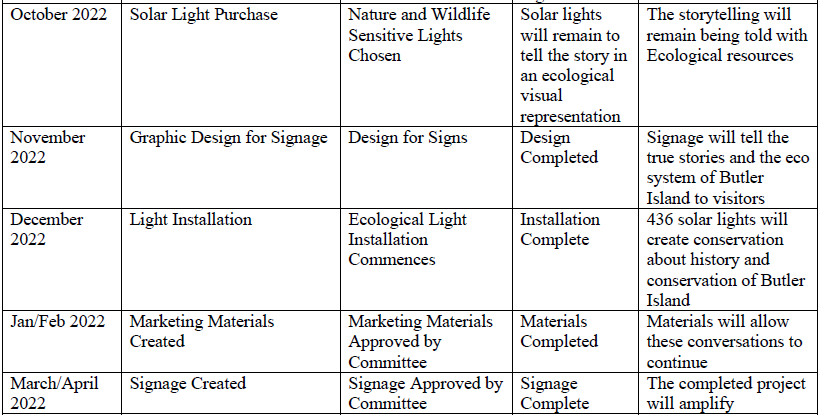|
Ecological
Sensitive Solar Light Project |
| |
The purpose
behind this grant request for the Butler Island
Ecological Sensitive Solar Lights and Ecosystem
Signage is to procure funding for the Ecological
Sensitive Solar Lights, Signage, and Installment on
Butler Island, Georgia, to honor the 436 enslaved
listed for sale during the Weeping Time March 2-3.
1859 and explain the surrounding ecosystems on
Butler Island. The Weeping Time was the largest sale
of humans in the history of the United States.
Located just south of Darien where Cathead Creek
meets the Butler Rive, two major transportation
routes travel through Butler Island- Interstate 95
and US Highway 17. The ecological sensitive lights
will be placed close to US Hwy 17, which is on the
East Coast Greenway.
|
PROJECT
DETAILS
The Butler Island Plantation was one of the
largest plantations in the south. It is located just
south of downtown Darien across the Darien River on
Highway 17. The plantation was established in the
1790s by Major Pierce Butler of Philadelphia.
Through the labor of enslaved Africans and African
Americans, he cultivated the land on the Altamaha
Delta as a rice plantation. In 1859, Major Butlerís
grandson, Pierce Butler, encumbered by gambling
debts liquidated a portion of his assets, which were
436 enslaved people. These humans were sold at
auction March 2-3, 1859 in the largest slave sale in
American history, in what is now known as the
Weeping Time.
Today, remnants of a system of dikes and canals,
which were used for the cultivation of rice are
still apparent in the old fields. The site is now
owned by the State of Georgia, Department of Natural
Resources, and leased to the City of Darien, and the
land (excluding the 1920s era historic structures)
is open to the public for picnicking, fishing, and
birding. In 2009, a lease agreement, yet unclear
division of duties, between the Georgia Department
of Natural Resources and the City of Darien led to
demolition by neglect of the floodgates, rice dikes,
historic structures, trails, and docks. Only 3 signs
tell any history about Butler Island. Two were
placed to the Butler family in the 1950s, and one to
the enslaved in 2019. As such, this project
originated out of telling the true stories of Butler
Island, incorporating the ecology and wildlife
sensitive environment into the project. The story of
Butler Island includes itsí ecosystem, and the
project wants to include both, with solar lighting
and signage installation that will not hann its
nature. Flooding to the low-level site is prevalent,
and any signage or lights placed on the property
will have to take the sea levels into account when
planning.
OBJECTIVES
The Coastal Georgia Greenway is part of the East
Coast Greenway; a trail network that connects Maine
with Florida. The Island Hopper Trail is the
centerpiece of the Coastal Georgia Greenway; a
hike-and-bike trail network along Georgiaís Coast
that connects South Carolina with Florida. The
Island Hopper Trail is a 36-mile route that connects
Sapelo Island, St. Simons Island, and Jekyll Island.
It includes the Altamaha Scenic Byway; continuing
south on US Hwy I7, which travels through Butler
Island. Butler Island is also part of the Altamaha
Wildlife Management Area /Altamaha River Waterfowl
Area (AWMA/ARWA) which stretches for l7 miles along
the Altamaha River, which is the largest free flowing
water system on the Atlantic Coast. This refuge
provides many types of habitats that support a
variety of wildlife. Habitats along the river
include rice fields, pine savannas, tidal creeks,
hardwood floodplain forests, and old growth stands
of bald cypress. The wildlife viewing is one of the
best in the state for observing waterfowl for
numbers and diversity, and it is the second largest
waterfowl area east of the Mississippi.
ACTION PLAN
The Coordination and Installation will be a
collaborative effort between the Lower Altamaha
Historic Society (LAHS), The Coalition to Save
Butler Island, and The Weeping Time Commemorative
Committee. A Project committee will fonn with
members of these three groups consisting of
historians, and Dr. Kwesi DeGraft- Hanson, Ph.D.. a
Weeping Time research Butler Island Ecological
Sensitive Solar Lights and Ecosystem Signage
historian and landscape architect. Planning meetings
will occur the first Monday of every month until
April 2022.
SCHEDULE OF
EVENTS
Correction --The Oct,
Nov & Dec Dates below should be 2021 not 2022

|
|